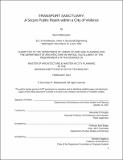| dc.contributor.advisor | Alexander D'Hooghe. | en_US |
| dc.contributor.author | Maliszewski, Ryan (Ryan R.) | en_US |
| dc.contributor.other | Massachusetts Institute of Technology. Dept. of Architecture. | en_US |
| dc.date.accessioned | 2012-04-26T18:51:10Z | |
| dc.date.available | 2012-04-26T18:51:10Z | |
| dc.date.copyright | 2012 | en_US |
| dc.date.issued | 2012 | en_US |
| dc.identifier.uri | http://hdl.handle.net/1721.1/70412 | |
| dc.description | Thesis (M.C.P.)--Massachusetts Institute of Technology, Dept. of Urban Studies and Planning; and, (M. Arch.)--Massachusetts Institute of Technology, Dept. of Architecture, 2012. | en_US |
| dc.description | Cataloged from PDF version of thesis. | en_US |
| dc.description | Includes bibliographical references (p. 186-187). | en_US |
| dc.description.abstract | With an increasing number of cities experiencing chronic violence and conflict within their boundaries, the question of how architecture can effectively intervene to create a secure public realm in pluralistic and fractious urban environments grows more vital. This thesis explores the spatial and social notion of sanctuary as an architectural strategy in such contexts, using the design of a central transit station in a northern neighborhood of Karachi, Pakistan as a case study. Drawing upon sociological theory as well as precedent projects ranging from Johannesburg to Bogota, we come to see the creation of sanctuary as a deliberate construction of shared identity and experience. This strategy draws on four tactics that shift both the built and psychological environment and work in tandem to reinforce and amplify each other's effects: -- Partition (the separation of 'sacred' content from the 'profane' context) -- Ritual (strengthening psychological security through the repeated and familiar) -- Appropriation (empowering people to take ownership of portions of the space) -- Monumentality (creating a physical object upon which common values can be projected) Using these tactics as a foundation, the design's architectural patterns engender a variety of systems to accommodate the diverse program and user demands incumbent within a project of this scale and complexity. Through this investigation, the design proposes a new type of defensible infrastructure, relying not only on fortifying a space but also on strengthening the psychological resilience of people through architectural intervention. | en_US |
| dc.description.statementofresponsibility | by Ryan Maliszewski. | en_US |
| dc.format.extent | 189 p. | en_US |
| dc.language.iso | eng | en_US |
| dc.publisher | Massachusetts Institute of Technology | en_US |
| dc.rights | M.I.T. theses are protected by
copyright. They may be viewed from this source for any purpose, but
reproduction or distribution in any format is prohibited without written
permission. See provided URL for inquiries about permission. | en_US |
| dc.rights.uri | http://dspace.mit.edu/handle/1721.1/7582 | en_US |
| dc.subject | Urban Studies and Planning. | en_US |
| dc.subject | Architecture. | en_US |
| dc.title | Transport sanctuary : a secure public realm within a city of violence | en_US |
| dc.title.alternative | Secure public realm within a city of violence | en_US |
| dc.type | Thesis | en_US |
| dc.description.degree | M.Arch. | en_US |
| dc.description.degree | M.C.P. | en_US |
| dc.contributor.department | Massachusetts Institute of Technology. Department of Architecture | |
| dc.contributor.department | Massachusetts Institute of Technology. Department of Urban Studies and Planning | |
| dc.identifier.oclc | 785141724 | en_US |
